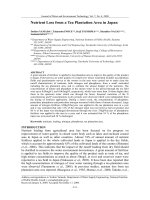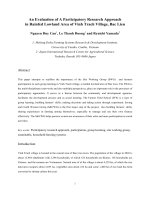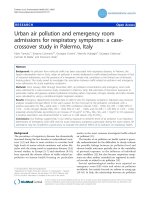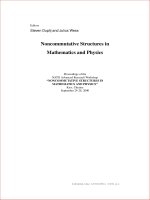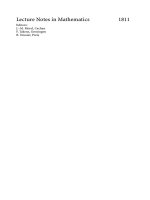a few classic unknowns in mathematics
Bạn đang xem bản rút gọn của tài liệu. Xem và tải ngay bản đầy đủ của tài liệu tại đây (15.52 KB, 5 trang )
A FEW CLASSIC UNKNOWNS IN MATHEMATICS
Get any book for free on: www.Abika.com
1
A Few Classic Unknowns in
Mathematics
By Professor G. A. Miller
Get any book for free on: www.Abika.com
A FEW CLASSIC UNKNOWNS IN MATHEMATICS
Get any book for free on: www.Abika.com
2
A Few Classic Unknowns in Mathematics
KING HIERO is said to have remarked, in view of the marvelous mechanical devices of
Archimedes, that he would henceforth doubt nothing that had been asserted by Archimedes. This
spirit of unbounded confidence in those who have exhibited unusual mathematical ability is still
extant. Even our large city papers sometimes speak of a mathematical genius who could solve
every mathematical problem that was proposed to him. The numerous unexpected and far-
reaching results contained in the elementary mathematical text-books, and the ease with which
the skilful mathematics teachers often cleared away what appeared to be great difficulties to the
students have filled many with a kind of awe for unusual mathematical ability.
In recent years the unbounded confidence in mathematical results has been somewhat shaken by
a wave of mathematical skepticism which gained momentum through some of the popular
writings of H. Poincare and Bertrand Russell. As instances of expressions which might at first
tend to diminish such confidence we may refer to Poincare's contention that geometrical axioms
are conventions guided by experimental facts and limited by the necessity to avoid all
contradictions, and to Russell's statement that "mathematics may be defined as the subject in
which we never know what we are talking about nor whether what we are saying is true."
The mathematical skepticism which such statements may awaken is usually mitigated by
reflection, since it soon appears that philosophical difficulties abound in all domains of
knowledge, and that mathematical results continue to inspire relatively the highest degrees of
confidence. The unknowns in mathematics to which we aim to direct attention here are not of
this philosophical type but relate to questions of the most simple nature. It is perhaps unfortunate
that in the teaching of elementary mathematics the unknowns receive so little attention. In fact, it
seems to be customary to direct no attention whatever to the unsolved mathematical difficulties
until the students begin to specialize in mathematics in the colleges or universities.
One of the earliest opportunities to impress on the student the fact that mathematical knowledge
is very limited in certain directions presents itself in connection with the study of prime numbers.
Among the small prime numbers there appear many which differ only by 2. For instance, 3 and
5, 5 and 7, 11 and 13, 17 and 19, 29 and 31, constitute such pairs of prime numbers. The question
arises whether there is a limit to such pairs of primes, or whether beyond each such pair of prime
numbers there must exist another such pair.
This question can be understood by all and might at first appear to be easy to answer, yet no one
has succeeded up to the present time in finding which of the two possible answers is correct. It is
interesting to note that in 1911 E. Poincare transmitted a note written by M. Merlin to the Paris
Academy of Sciences in which a theorem was announced from which its author deduced that
there actually is an infinite number of such prime number pairs, but this result has not been
accepted because no definite proof of the theorem in question was produced.
Another unanswered question which can be understood by all is whether every even number is
the sum of two prime numbers. It is very easy to verify that each one of the small even numbers
is the sum of a pair of prime numbers, if we include unity among the prime numbers; and, in
A FEW CLASSIC UNKNOWNS IN MATHEMATICS
Get any book for free on: www.Abika.com
3
1742, C. Goldbach expressed the theorem, without proof, that every possible even number is
actually the sum of at least one pair of prime numbers. Hence this theorem is known as
Goldbach's theorem, but no one has as yet succeeded in either proving or disproving it.
Although the proof or the disproof of such theorems may not appear to be of great consequence,
yet the interdependence of mathematical theorems is most marvelous, and the mathematical
investigator is attracted by such difficulties of long standing. These particular difficulties are
mentioned here mainly because they seem to be among the simplest illustrations of the fact that
mathematics is teeming with classic unknowns as well as with knowns. By classic unknowns we
mean here those things which are not yet known to any one, but which have been objects of
study on the part of mathematicians for some time. As our elementary mathematical text-books
usually confine themselves to an exposition of what has been fully established, and hence is
known, the average educated man is led to believe too frequently that modern mathematical
investigations relate entirely to things which lie far beyond his training.
It seems very unfortunate that there should be, on the part of educated people, a feeling of total
isolation from the investigations in any important field of knowledge. The modern mathematical
investigator seems to be in special danger of isolation, and this may be unavoidable in many
cases, but it can be materially lessened by directing attention to some of the unsolved
mathematical problems which can be most easily understood. Moreover, these unsolved
problems should have an educational value since they serve to exhibit boundaries of modern
scientific achievements, and hence they throw some light on the extent of these achievements in
certain directions.
Both of the given instances of unanswered classic questions relate to prime numbers. As an
instance of one which does not relate to prime numbers we may refer to the question whether
there exists an odd perfect number. A perfect number is a natural number which is equal to the
sum of its aliquot parts. Thus 6 is perfect because it is equal to 1 + 2 + 3, and 28 is perfect
because it is equal to 1 + 2 + 4 + 7 + 14. Euclid stated a formula which gives all the even perfect
numbers, but no one has ever succeeded in proving either the existence or the non-existence of
an odd perfect number. A considerable number of properties of odd perfect numbers are known
in case such numbers exist.
In fact, a very noted professor in Berlin University developed a series of properties of odd
perfect numbers in his lectures on the theory of numbers, and then followed these developments
with the statement that it is not known whether any such numbers exist. This raises the
interesting philosophical question whether one can know things about what is not known to exist;
but the main interest from our present point of view relates to the fact that the meaning of odd
perfect number is so very elementary that all can easily grasp it, and yet no one has ever
succeeded in proving either the existence or the non-existence of such numbers.
It would not be difficult to increase greatly the number of the given illustrations of unsolved
questions relating directly to the natural numbers. In fact, the well-known greater Fermat
theorem is a question of this type, which does not appear more important intrinsically than many
others but has received unusual attention in recent years on account of a very large prize offered
for its solution. In view of the fact that those who have become interested in this theorem often
A FEW CLASSIC UNKNOWNS IN MATHEMATICS
Get any book for free on: www.Abika.com
4
experience difficulty in finding the desired information in any English publication, we proceed to
give some details about this theorem and the offered prize. The following is a free translation of
a part of the announcement made in regard to this prize by the Konigliche Gesellschaft der
Wissenschaften, Gottingen, Germany:
On the basis of the bequest left to us by the deceased Dr. Paul Wolskehl, of Darmstadt, a prize of
100,000 mk., in words, one hundred thousand marks, is hereby offered to the one who will first
succeed to produce a proof of the great Fermat theorem. Dr. Wolfskehl remarks in his will that
Fermat had maintained that the equation
xq + yq = zq
could not be satisfied by integers whenever q is an odd prime number. This Fermat theorem is to
be proved either generally in the sense of Fermat, or, in supplementing the investigations by
Kummer, published in Crelle's Journal, volume 40, it is to be proved for all values of q for which
it is actually true. For further literature consult Hibert's report on the theory of algebraic number
realms, published in volume 4 of the Jahreshericht der Deutschen Mathernatiker-Vereinigung,
and volume 1 of the Encyklopadie der mathematischen Wissenschaften.
The prize is offered under the following more particular conditions.
The Konigliche Gesellschaft der Wissenschaften in Gottingen decides independently on the
question to whom the prize shall be awarded. Manuscripts intended to compete for the prize will
not be received, but, in awarding the prize only such mathematical papers will be considered as
have appeared either in the regular periodicals or have been published in the form of monographs
or books which were for sale in the book-stores. The Gesellschaft leaves it to the option of the
author of such a paper to send to it about five printed copies.
Among the additional stipulations it may be of interest to note that the prize will not be awarded
before at least two years have elapsed since the first publication of the paper which is adjudged
as worthy of the prize. In the meantime the mathematicians of various countries are invited to
express their opinion as regards the correctness of this paper. The secretary of the Gesellschaft
will write to the person to whom the prize is awarded and will also publish in various places the
fact that the award has been made. If the prize has not been awarded before September 13, 2007,
no further applications will be considered.
While this prize is open to the people of all countries it has become especially well known in
Germany, and hundreds of Germans from a very noted university professor of mathematics to
engineers, pastors, teachers, students, bankers, officers, etc., have published supposed proofs.
These publications are frequently very brief, covering only a few pages, and usually they
disclose the fact that the author had no idea in regard to the real nature of the problem or the
meaning of a mathematical proof. In a few cases the authors were fully aware of the
requirements but were misled by errors in their work. Although the prize was formally
announced more than seven years ago no paper has as yet been adjudged as fulfilling the
conditions.
A FEW CLASSIC UNKNOWNS IN MATHEMATICS
Get any book for free on: www.Abika.com
5
It may be of interest to note in this connection that a mathematical proof implies a marshalling of
mathematical results, or accepted assumptions, in such a manner that the thing to be proved is a
NECESSARY consequence. The non-mathematician is often inclined to think that if he makes
statements which can not be successfully refuted he has carried his point. In mathematics such
statements have no real significance in an attempted proof. Unknowns must be labeled as such
and must retain these labels until they become knowns in view of the conditions which they can
be proved to satisfy. The pure mathematician accepts only necessary conclusions with the
exception that basal postulates have to be assumed by common agreement.
The mathematical subject in which the student usually has to contend most frequently with
unknowns at the beginning of his studies is the history of mathematics. The ancient Greeks had
already attempted to trace the development of every known concept, but the work along this line
appears still in its infancy. Even the development of our common numerals is surrounded with
many perplexing questions, as may be seen by consulting the little volume entitled "The Hindu-
Arabic Numerals," by D. E. Smith and L. C. Karpinski.
The few mathematical unknowns explicitly noted above may suffice to illustrate the fact that the
path of the mathematical student often leads around difficulties which are left behind. Sometimes
the later developments have enabled the mathematicians to overcome some of these difficulties
which had stood in the way for more than a thousand years. This was done, for instance, by
Gauss when he found a necessary and sufficient condition that a regular polygon of a prime
number of sides can be constructed by elementary methods. It was also done by Hermite,
Lindemann and others by proving that epsilon and rho are transcendental numbers. While such
obstructions are thus being gradually removed some of the most ancient ones still remain, and
new ones are rising rapidly in view of modern developments along the lines of least resistance.
These obstructions have different effects on different people. Some fix their attention almost
wholly on them and are thus impressed by the lack of progress in mathematics, while others
overlook them almost entirely and fix their attention on the routes into new fields which avoid
these difficulties. A correct view of mathematics seems to be the one which looks at both,
receiving inspiration from the real advances but not forgetting the desirability of making the
developments as continuous as possible. At any rate the average educated man ought to know
that there is no mathematician who is able to solve all the mathematical questions which could be
proposed even by those having only slight attainments along this line.
